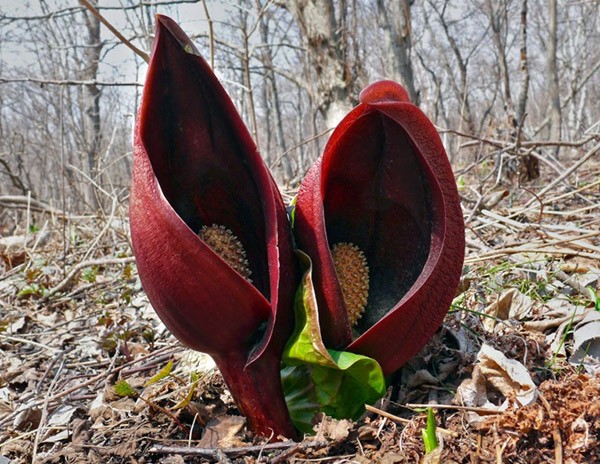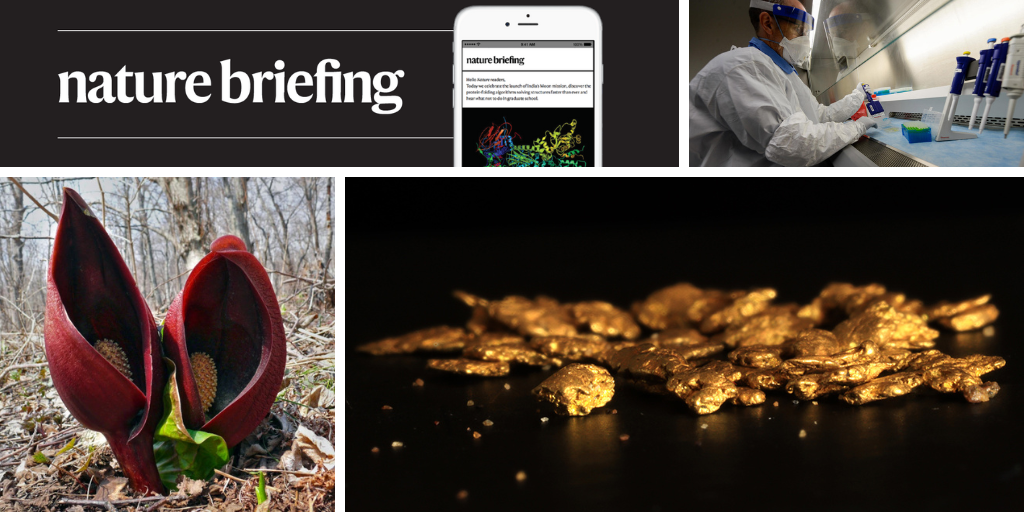You have full access to this article via your institution.
Hello Nature readers, would you like to get this Briefing in your inbox free every day? Sign up here.

Disulfide synthase differs from an enzyme commonly found in plants and animals by just three amino acids. (Kirsanov Valeriy Vladimirovich/Shutterstock)
A small tweak to a common plant enzyme gives the skunk cabbage (Symplocarpus renifolius) and several other stinky plants the ability to produce their stench. The tweaked enzyme, called disulfide synthase, converts molecules containing sulfur into the compounds responsible for the flowers’ foul smells. Researchers also found that scents such as faeces or rotting meat are surprisingly popular in the plant kingdom. Species in one plant genus evolved the ability to make such smells repeatedly in less than 7 million years — a blink of an eye in evolutionary terms.
For a fraction of a second, physicists at the Large Hadron Collider can turn lead into gold. The experiment fired two beams of lead ions at each other at near the speed of light. When the beams brush past each other, rather than colliding head on, the intense electromagnetic field around an ion can create a pulse of energy that triggers an oncoming lead nucleus to eject three protons — turning it into a gold nucleus that lasts around 1 microsecond. CERN researchers say they have no plans to take up gold-making as a side hustle — it’s a lot more expensive than getting gold the old-fashioned way.
Reference: Physical Review Journals paper
US President Donald Trump has issued an executive order suspending all federal funding for ‘gain of function’ research — defined as studies on infectious pathogens or toxins that have the potential to make them more deadly or transmissible — for four months. The order halts funding for work the Trump administration considers dangerous, but some scientists say the order is so broad that low-risk research will also be affected. It’s difficult to predict whether changes to viruses will make them more pathogenic to people, so researchers might have to avoid some virus research altogether, says biosecurity expert Gigi Gronvall.
Features & opinion
A space captain learns that humans aren’t as interesting as we think we are in the latest short story for Nature’s Futures series.
Andrew Robinson’s pick of the top five science books to read this week includes a peek behind the curtain at one of China’s most powerful tech companies and the late Pope Francis’s journey from chemical technician to the papacy, in his own words.
Fishing tends to take older herring (Clupea harengus) out of the shoal, leaving younger, less experienced fish struggling to find their traditional spawning grounds. “The experienced fish will tend to go in a direction they have been before to where it is a good place to spawn,” marine scientist Aril Slotte tells the Nature Podcast. The loss of this knowledge has led to the fish suddenly migrating around 800 kilometres poleward, disrupting fishing and ecosystems on the southwest coast of Norway.
Nature Podcast | 37 min listen
Subscribe to the Nature Podcast on Apple Podcasts, Spotify or YouTube Music, or use the RSS feed.
Today our penguin-search puzzle sees Leif Penguinson exploring a dry river bed in the vast woodlands of Pilliga Nature Reserve in Australia. Can you find the penguin?
The answer will be in Monday’s e-mail, all thanks to Briefing photo editor and penguin wrangler Tom Houghton.
This newsletter is always evolving — tell us what you think! Please send your feedback to [email protected].
Thanks for reading,
Flora Graham, senior editor, Nature Briefing
With contributions by Jacob Smith
Want more? Sign up to our other free Nature Briefing newsletters:
• Nature Briefing: Careers — insights, advice and award-winning journalism to help you optimize your working life
• Nature Briefing: Microbiology — the most abundant living entities on our planet — microorganisms — and the role they play in health, the environment and food systems
• Nature Briefing: Anthropocene — climate change, biodiversity, sustainability and geoengineering
• Nature Briefing: AI & Robotics — 100% written by humans, of course
• Nature Briefing: Cancer — a weekly newsletter written with cancer researchers in mind
• Nature Briefing: Translational Research — covers biotechnology, drug discovery and pharma


